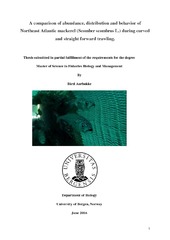| dc.description.abstract | Northeast Atlantic Mackerel (Scomber scombrus) is one of the largest and economically most valuable fish stocks in the world. However, due to a large area of distribution, low acoustic backscatter and highly dynamic and migratory behaviour between several Exclusive Economic Zones (EEZs), reliable abundance estimation and fish stock assessment are difficult and include a large level of uncertainty. In order to reduce uncertainties in the mackerel stock abundance estimates, a new pelagic trawl methodology and standardized swept-area surveys for mackerel abundance estimation was established in 2011. The new method included development of a new surface trawling method and a new trawl, the multipurpose pelagic ecosystem trawl (Multpelt 832). However, various uncertainty is still linked to the new trawl methodology. This thesis uses Deep Vision images, GoPro videos and total catch data from a methodological cruise conducted in June 2015 as well as catch data from the 2015 International Ecosystem Summer Survey in the Nordic Seas (IESSNS) in order to investigate the demanding curved trawl method used in the IESSNS survey today. The analyses conducted show that the curved trawling method did not have significantly different catch rates or length distribution compared to less demanding straight forward trawling. Consequently, a change of the trawling method used in the IESSNS survey from a curved to a straight forward trawling procedure is recommended in order to simplify trawling. Furthermore, analyses of mackerel distribution during the methodological survey indicate small shoaling and loosely aggregating behaviour within individual hauls. Patchiness rarely led to only a single or few aggregations being encountered over the course of 30-minute- long hauls, supporting the use of a swept area survey for mackerel in this location and time. The swept area method in the IESSNS survey therefore seems to be a reliable and consistent method for abundance estimation of NEA mackerel. | en_US |
